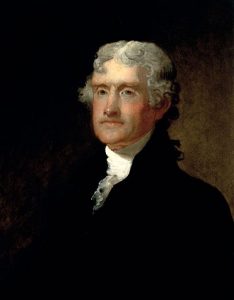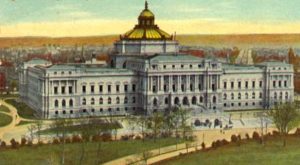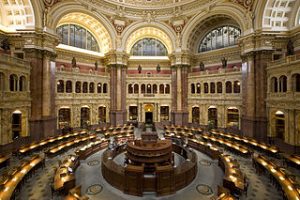When you think of Washington D.C., what comes to mind? Most people think of visiting the White House, the Capital Building, and Mount Vernon. Maybe various exhibits at the Smithsonian Museum. But, unless you’re an academic researcher, you might overlook the Library of Congress, and it’s well worth an excursion.
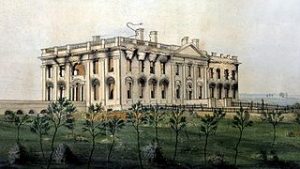
Congress established the Library with an appropriation of $5000 in 1800 to provide reference materials for the government.** The following year, 740 books and three maps arrived from London booksellers. The British burned the library along with most of city’s public buildings when they raided Washington on August 24, 1814. At the White House they found a table set for 40 diners and sensibly decided to enjoy the food and wine before destroying the residence.
Thomas Jefferson immediately offered to sell his personal library of over 9,000 volumes at a price determined by Congress. Regarding the breadth of topics under consideration, Jefferson wrote, “I do not know that it contains any branch of science which congress would wish to exclude from this collection…there is in fact no subject to which a member of congress may not have reason to refer.”
The purchase price worked out to $23,950, an amount based on the measurements of the sizes of all the books. In April 1815, ten wagons left Monticello carrying 6,707 volumes packed in pine cases. A new Library of Congress was born.
THE MODERN LIBRARY OF CONGRESS
Over the years the Library outgrew its space in the Capital Building and in 1897 moved into its own structure. When it opened, the Library of Congress building was considered the most beautiful building in the city.
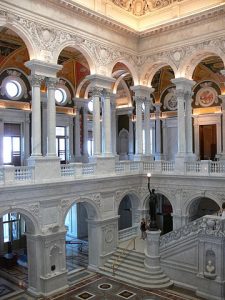
The design was based on the Paris Opera House, in a style now called Beaux Arts -neo-classical.
Today as Carla Hayden’s tenure as the fourteenth Librarian begins, the Library of Congress has three additional buildings – the John Adams Building (1939), the James Madison Memorial Building (1976), and the Packard Campus for Audio-Visual Conservation (2007). The collection containing over 162 million items is overseen by a staff of 31,000 employees, and an annual budget of nearly $650 million.
Hmmm….I need to schedule some research time in the Main Reading Room.
** [If you’re wondering what the value of $5000 in 1814 would be today, I can only share that $5000 in 1914 is worth $118,262.50 in 2016. Calculation from Saving.org.]
???
Featured Image: Library of Congress Logo in 2008. Public Domain. Wikimedia Commons.
Pictures:
The President’s House c. 1814 by George Munger. Public Domain. Wikimedia Commons.
Thomas Jefferson, c. 1817-1827 by Mathew Harris Jouett. Public Domain. Wikimedia Commons.
Library of Congress Building. 1910 Postcard. Public Domain. Wikimedia Commons.
Great Hall of the Jefferson Building by Andreas Praefcke. Creative Commons Attribution.
Carla Hayden. Public Domain. Wikimedia Commons.
Main Reading Room. Library of Congress. Public Domain. Wikimedia Commons.
Thomas Jefferson Building. Architect of the Capital.
Sofia Samee Ali. “Carla Hayden to be Sworn in.” NBC News. Sept 14, 2016.
Nicholas Fandos. “New Librarian of Congress.” The New York Times. Sept 14, 2016.

Sandra Wagner-Wright holds the doctoral degree in history and taught women’s and global history at the University of Hawai`i. Sandra travels for her research, most recently to Salem, Massachusetts, the setting of her new Salem Stories series. She also enjoys traveling for new experiences. Recent trips include Antarctica and a river cruise on the Rhine from Amsterdam to Basel.
Sandra particularly likes writing about strong women who make a difference. She lives in Hilo, Hawai`i with her family and writes a blog relating to history, travel, and the idiosyncrasies of life.


